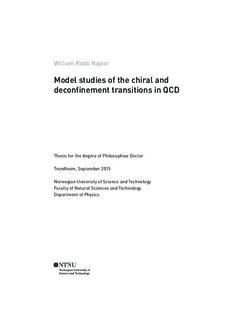| dc.contributor.author | Naylor, William Robb | |
| dc.date.accessioned | 2015-10-01T10:38:25Z | |
| dc.date.available | 2015-10-01T10:38:25Z | |
| dc.date.issued | 2015 | |
| dc.identifier.issn | 1503-8181 | |
| dc.identifier.uri | http://hdl.handle.net/11250/1578857 | |
| dc.description.abstract | The force that is responsible for holding the nucleus together and for creating protons and neutrons (via the binding of even smaller particles,called quarks) is the strong nuclear force. Of the four fundamental forces of nature, the strong force is (unsurprisingly) the strongest but also has the shortest range. Its short range arises from the fact that the force attracts to itself, and thus produces very tangled configurations.
The theory of the strong nuclear force is Quantum ChromoDynamics (QCD). This theory accounts for the tangled nature of the force it describes. A result is that making calculations directly from the theory is almost impossible. Hence we follow the work of many others by instead using simplified models of QCD that approximate the theory for a certain range of temperatures and pressures.
QCD is also studied experimentally via high energy collisions, such as the experiments ongoing at the Large Hadron Collider at CERN. A byproduct of these collisions is extremely intense magnetic fields.
Currently there is disagreement between model calculations (which we do) and brute force calculations of QCD using supercomputers (lattice-QCD) as to what the effect of these large magnetic fields is on QCD.
In this thesis we give one of the most complete studies of a model of QCD including a magnetic field and explore some of the mathematical details that have arisen as people search for consensus between models and lattice-QCD. In addition, we investigate some of the subtleties that arise when comparisons are made between model studies and lattice- QCD and suggest ways in which these can be accounted for. | nb_NO |
| dc.language.iso | eng | nb_NO |
| dc.publisher | NTNU | nb_NO |
| dc.relation.ispartofseries | Doctoral thesis at NTNU;2015:238 | |
| dc.relation.haspart | Paper 1: Andersen, Jens Oluf; Naylor, William; Tranberg, Anders. Chiral and deconfinement transitions in a magnetic background using the functional renormalization group with the Polyakov loop. Journal of High Energy Physics (JHEP) 2014 ;Volum 2014.(4)
<a href="http://dx.doi.org/10.1007/JHEP04(2014)187" target="_blank"> http://dx.doi.org/10.1007/JHEP04(2014)187</a>
Open Access, (c)The Authors.
Article funded by SCOAP | nb_NO |
| dc.relation.haspart | Paper 2: Andersen, Jens Oluf; Naylor, William; Tranberg, Anders. Inverse magnetic catalysis and regularization in the quark-meson model. Journal of High Energy Physics (JHEP) 2015 ;Volum 2015.(2) s. 1-14 <a href="http://dx.doi.org/10.1007/JHEP02(2015)042" target="_blank"> http://dx.doi.org/10.1007/JHEP02(2015)042</a>
Open Access, (c)The Authors.
Article funded by SCOAP | nb_NO |
| dc.relation.haspart | Paper 3: Jens O. Andersen, Tom´aˇs Brauner and William R. Naylor. Confronting effective models for deconfinement in dense quark matter with lattice data. arXiv:1505.05925, 2015. The final version is available at <a href="http://dx.doi.org/10.1103/PhysRevD.92.114504" target="_blank"> http://dx.doi.org/10.1103/PhysRevD.92.114504</a>
© 2015 American Physical Society | nb_NO |
| dc.title | Model studies of the chiral and deconfinement transitions in QCD | nb_NO |
| dc.type | Doctoral thesis | nb_NO |
| dc.subject.nsi | VDP::Mathematics and natural science: 400::Physics: 430 | nb_NO |
